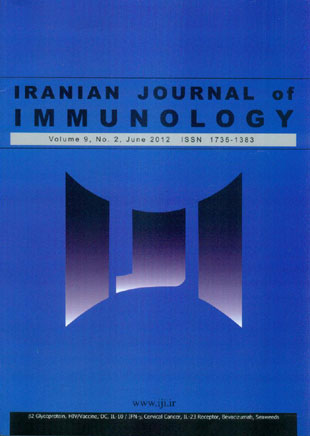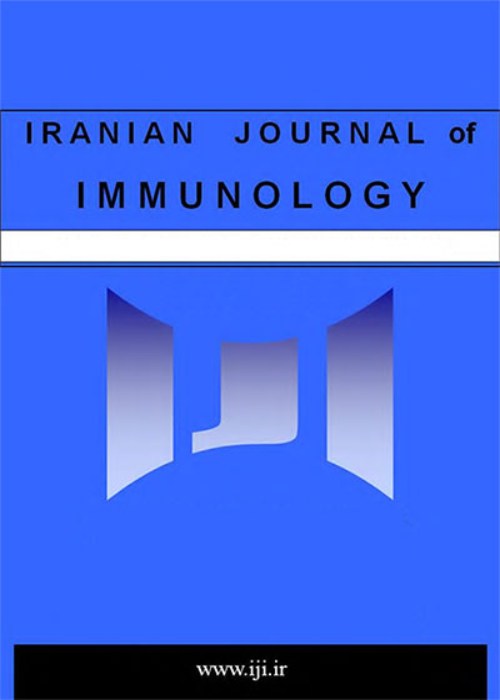فهرست مطالب

Iranian journal of immunology
Volume:9 Issue: 2, Spring 2012
- 80 صفحه،
- تاریخ انتشار: 1391/06/10
- تعداد عناوین: 8
-
-
Pages 73-85Beta 2 glycoprotein I (β2GPI) is a single chain 50 kDa highly glycosylated glycoprotein at an approximate concentration of 4 μM in cells. The abundance of this protein in plasma and its high state of preservation indicate the important role of this protein in mammalian. In addition, β2GPI has a particular structure in the fifth domain, and is categorized as the major antigen recognized by autoantibodies present in antiphospholipid syndrome. Beta 2 glycoprotein I has been usually studied in the context of antiphospholipid antibody production. Complexes of β2GPI/anti-β2GPI antibodies have been examined in different coagulation and cell activation pathways. However, the function of β2GPI, independent from the antibodies, has not been clearly determined. In this paper different features of β2GPI including its structure, plasma concentration and its proposed in vitro and in vivo functions in clot formation and fibrinolysis along with anti-β2GPI antibodies (Abs) are discussed. Their inhibitory or promotive effects are delineated in each facet.
-
Pages 86-97BackgroundDevelopment of an effective vaccine is highly needed in order to restrict the AIDS pandemic. DNA vaccines initiate both arms of immunity without the potential of causing disease. HIV-1 p24 and gp41 (gag and env) proteins play important roles in viral pathogenesis and are effective candidates for immune induction and vaccine design.ObjectiveIn this study, new DNA vaccine candidates constructed from HIV-1 fused p24- gp41 or gp41 alone were evaluated in Balb/c mice for induction of cellular and humoral immune responses.MethodsRecombinant plasmids, pcDNA3.1/Hygro expression vector containing immunogenic sequences of fused p24-gp41 or gp41alone were produced. Dendrosome used as a system for carrying vectors in laboratory animals, and an IL-12 containing vector (pCAGGS-IL-12) was co-immunized with the p24-gp41 vector as a genetic adjuvant. Induction of effective immune responses against the designed vectors as DNA vaccine candidates in Balb/c mice was evaluated. Levels of total antibodies, IgG isotypes (IgG2a and IgG1); IFN-γ and IL-4 were measured by ELISA. MTT assay was used to evaluate lymphoproliferation.ResultsThe results confirmed that the immunogenic epitopes of both p24 and gp41 genes are highly effective inducers of immune responses, and administration of fused p24-gp41 alone or along with IL-12 resulted in further enhancement of immune responses. Group 4 that received fused fragments (p24-gp41) along with an IL-12 expressing vector demonstrated a significantly higher Stimulation Index (SI) and IFN- production (p<0.0001) with a significant increase in IgG2a/IgG1 ratio, indicating the stimulation of CMI towards Th1. Although gp41 containing vector (group 6) also showed significant increases in both proliferation and IFN- production, the responses were persistently lower than that of p24-gp41 containing vectors. Total antibody production was highest in group 6 as expected.ConclusionDendrosome proved to be an efficient carrier of recombinant plasmids constructed in this study. Further studies are necessary to evaluate these constructs as HIV vaccine candidates.Keywords: Dendrosome, DNA Vaccine, gp41, HIV, 1, IL, 12, p24
-
Pages 98-108BackgroundGeneration of an effective dendritic cell (DC) based cancer vaccine depends on appropriate differentiation of monocytes in vitro.ObjectiveTo compare the effects of monocyte separation methods, flask adherence (Flask-DC) and magnetic activated cell sorting (MACS-DC), on phenotypic and functional characteristics of resultant DCs.MethodsDCs from healthy volunteers were generated from plastic adherence and MACS isolated monocytes in the presence of GM-CSF and IL-4 as well as TNF-α and monocyte conditioned medium (MCM) in 7 day cultures. Mature DCs were then subjected to phenotypic analysis using anti-CD14, anti-CD83 and HLA-DR monoclonal antibodies. Functional and cytokine release assays were carried out using [3H] thymidine uptake test and commercially available ELISA kits for the determination of IL-12, IL-10, IFN-γ and IL-4, respectively.ResultsWe found that MACS-DCs were more homogenous and the yield and viability were fairly higher than Flask-DCs. MACS-DCs expressed higher levels of CD83 and HLA-DR as well as CD14 compared to the Flask-DCs. Induction of T cell proliferative responses were higher in Flask-DCs and also they elicited higher levels of IL-12: IL-10 and IFN-γ: IL-4 ratios in cytokine generation assays.ConclusionMACS method was superior for mass production of viable homogenous and fully mature DCs but their cytokine profile had the potential to polarize the immune system toward Th2 type immune response.Keywords: Adherence, Cell Separation, Dendritic Cell, Phenotype, Th2
-
Pages 109-118BackgroundMalassezia furfur is a lipophilic yeast that causes skin disease.ObjectiveTo evaluate the level of IL-10, IFN-γ and IL-12P70 in co-incubation of peripheral blood mononuclear cells (PBMCs) with M. furfur grown in the presence of some different types of natural oils.MethodsPBMCs were obtained from blood samples of normal volunteers. M. furfur was cultured in different culture media containing almond oil, fish oil, walnut oil, fullfat milk, and a fat-free medium; and the yeasts grown were harvested and used for coincubation with PBMCs in vitro. The IFN-γ, IL-10, and IL-12P70 levels were measured at different time intervals using ELISA methods.ResultsGenerally, IFN-γ and IL-10 levels in the co-incubation of yeasts with walnut oil group (WOG) and fish oil group (FOG) were higher than those in the almond oil group (AOG) and full-fat milk group (FFMG). Although the IL-12P70 was higher in groups such as AOG, FOG, and WOG; the increase was not statistically significant.ConclusionThe results demonstrated that the type of fat used by M. furfur in the culture media can influence the immune response and increases IFN-γ and IL-10 levels in an early time point of the culture system.Keywords: IL, 10, IFN, IL, 12, Malassezia furfur, Natural Oil, PBMC
-
Pages 119-127BackgroundGenistein (GEN), a naturally occurring flavonoid present in soy bean, has attracted scientific interest for its possible benefits in cancer.ObjectiveThe potential immunomodulatory effects of genistein on the immune system and against TC-1 tumor cell line were evaluated in adult female C57BL/6 mice.MethodsMice were treated with GEN 10 days before to 10 days after the tumor induction. Thirty days after the last GEN treatment, lymphocyte proliferation, Lactase Dehydrogenase (LDH) cytolytic activity and cytokine secretion were analyzed in GEN and control groups.ResultsThe results showed that ingestion of genistein significantly increased lymphocyte proliferation and LDH release. Furthermore, the treatment with genistein also caused a significant increment in interferon gamma (IFN-γ). In addition, the treatment achieved significant therapeutic effect in tumor models compared to the control group. These results indicated that the effect of GEN on tumor growth may be attributed to its effect on lymphocyte proliferation, cytolytic activity and IFN-γ production.ConclusionThese results demonstrate that GEN exerts an immunomodulatory effect in a mouse model of Human Papillomavirus (HPV) associatedcervical cancer.Keywords: Cervical Cancer, Genistein, Human Papillomavirus, Imunomodulation, TC
-
Pages 128-135BackgroundCrohn’s disease (CD) and ulcerative colitis (UC) are two major clinical presentations of inflammatory bowel disease (IBD). Many novel candidate genes have been found to be associated with increased risk for IBD. Recently IL-23 receptor gene is identified as an IBD associated gene in genome-wide studies.ObjectiveTo ascertain whether rs7517847 and rs1004819 SNPs in the IL-23 receptor gene are associated with UC in our population in Kerman, south east of Iran.MethodsA total of 85 patients with UC and 100 healthy controls enrolled in our study. Endoscopic procedure was performed for all patients to determine their disease severity. IL-23 receptor genotyping at positions rs7517847 and rs1004819 was done by PCR-RFLP technique.ResultsThe results of this study showed no association between the studied polymorphisms in the IL-23 receptor gene and UC in our population. However, we found a significant association between rs7517847 gene polymorphism in IL-23 receptor and two important clinical variables including blood in stool and bowel movements in UC patients.ConclusionThe rs7517847 gene polymorphism in IL-23R may be related to the presence of blood in stool and bowel movements in patients with UC. Further functional analysis with other known IL-23 receptor genotypes and/or other candidate genes is necessary to confirm any genetic association with UC in our population.Keywords: IL, 23R, Iran, rs7517847, rs1004819, Ulcerative Colitis
-
Pages 136-144BackgroundCystoid Macular Edema (CME) is one of the most common and sight threatening complications of uveitis. Intravitreal injection of corticosteroids and anti-VEGF antibody are two routine options for treatment.ObjectiveTo compare the effects of intravitreal injections of Bevacizumab and Triamcinolone Acetonide for the treatment of persistent macular edema in non-infectious uveitis.MethodsIn a randomized clinical trial, sixty eyes of 55 patients were enrolled in the study. Patients were divided into two groups with randomized digits table. 29 eyes received 4 mg of intravitreal triamcinolone acetonide, and 31 eyes received 1.25 mg of intravitreal bevacizumab. Two main outcome measures were changes in visual acuity, measured with logarithm of minimal angle of resolution, and central macular thickness, measured with optical coherence tomography.ResultsThe mean followup was 25.3 weeks. The best visual acuities were achieved 6 months after injection in both groups. Improvement in visual acuity at 6 months was achieved in 28/29 (96%) of eyes in Triamcinolone group and in 26/31 (83%) eyes in Bevacizumab group (p=0.196). None of the eyes showed worsening of visual acuity after 6 months. Mean of central macular thickness in the pre-injection time for intravitreal triamcinolone acetonide (IVTA) group was 295.62 μ, and 309.87 μ in intravitreal bevacizumab (IVB) group, which were decreased after six months to 199.27 μ and 221.06 μ, respectively (p<0.001).ConclusionThis study shows that IVT and IVB are both effective in improving vision in uveitic CME. Although effects of triamcinolone on Central Macular Thickness (CMT) are more apparent, this superiority is not seen on Best Corrected Visual Acuity (BCVA).
-
Pages 145-148


